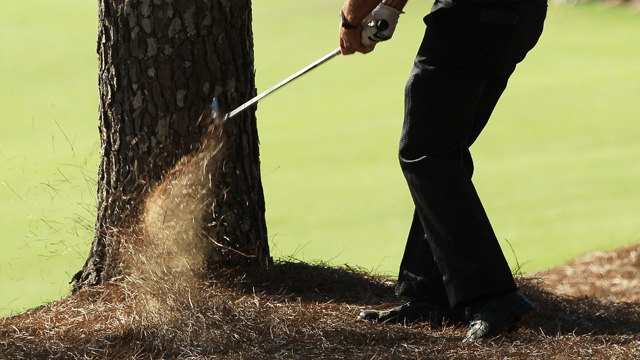NEWS
A Lesson Learned: Mickelson's mastery of the pinestraw nets him third green jacket

The shot of the week in this year's Masters (shot of the decades?) was from champion Phil Mickelson; an artful threading of a 6 iron between two trees and over Rae's Creek on the par 5, 13th hole.
The heroic shot off the pine straw set up a birdie and propelled him to victory. Mickelson reasoned that no matter what he chose to do, he'd have to hit it between those trees. So he decided to go for the green. Say what you will, the man now owns three green jackets from Augusta National. Congratulations to a great champion.
To many golf fans, Phil's tournament rounds always have an element of dramatic and exciting shot making - and this year's final round at Augusta National was no different. Further, many spectators wonder how he could be so accurate with such a difficult shot. I will help you to understand how Phil was able to pull off this shot with precision and confidence so that you can too.
When playing out of trouble, check the lie first. At the Masters, the world's best players have an advantage you may not when they miss a shot badly; hitting from pine straw. This is ideal for recovery shots because the ball will sit up cleanly, making it much easier for the club face to come into full contact with the ball. If your missed shot is covered in deep grass, you won't be able to make the play Phil did, so grab your wedge and aim for the widest opening to the fairway. If it is sitting cleanly, keep reading.
Next, pick the starting line of the recovery shot. Phil had to go between two trees positioned closely together. He aligned his shoulders, hips and feet squarely to the space between the trees, ensuring the swing path of his club would start the ball on this line. Where you aim your body, the ball will start its flight. On the practice range, place a club shaft on the ground between you and the ball aimed at your target to calibrate your alignment. This will prove useful when playing out of trouble. Finally, aim the club face at your target. In the case of Phil's shot, he aimed the club right, directly at the flag, de-lofting his 6 iron and effectively making the ball go farther. This is what we refer to as "closing" the club face. A closed club face makes the ball go lower as well as longer, so you may find a more lofted club is needed for this shot.
Phil and his caddie debated awhile about the club to use here, and he may have normally used a 5 iron from the fairway from the same distance out, but due to the way he set the club face, he used a 6 iron instead. Seems to have been the right call, wouldn't you say? And when it came time to execute the shot, Phil confidently powered through impact, knowing the exact trajectory, distance and shape his golf ball would travel. Many years of practice have made his confidence soar in these tight spots on the biggest stages in golf.
Try pulling off this shot during your next practice session to gain confidence for the time you need it on course. You will surely impress your golfing buddies, and lower your scores. Congratulations to Phil Mickelson, a true champion and role model to emulate, both on and off the course.
Joe Plecker is the PGA Director of Instruction at the Baltimore Country Club in Baltimore, Md. Long recognized as a one of the top golf instructors in the country by many media outlets - including Golf Digest's "Top Teachers In Your State", he has been named the 2007 Middle Atlantic PGA Teacher of the Year and has been a finalist for PGA National Teacher of the Year. Plecker is also the host of "Making the Rounds" on 105.7 FM The Fan in Maryland. Plecker is a member of the PGA.com Advisory Board. He can be reached at joe@joeplecker.com
